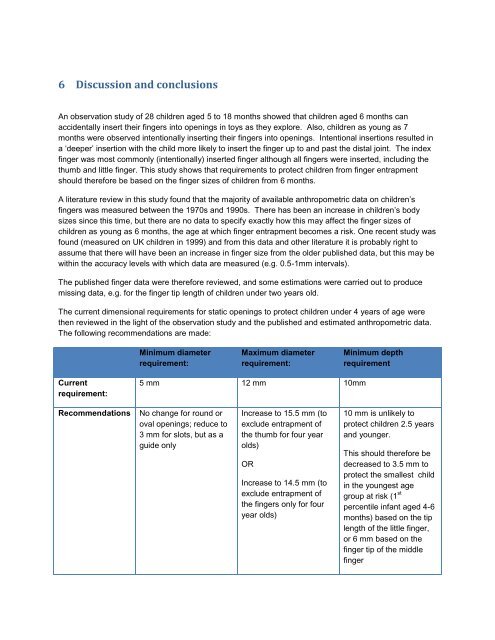Requirements for finger entrapment in European safety ... - ANEC
Requirements for finger entrapment in European safety ... - ANEC
Requirements for finger entrapment in European safety ... - ANEC
You also want an ePaper? Increase the reach of your titles
YUMPU automatically turns print PDFs into web optimized ePapers that Google loves.
6 Discussion and conclusions<br />
An observation study of 28 children aged 5 to 18 months showed that children aged 6 months can<br />
accidentally <strong>in</strong>sert their <strong>f<strong>in</strong>ger</strong>s <strong>in</strong>to open<strong>in</strong>gs <strong>in</strong> toys as they explore. Also, children as young as 7<br />
months were observed <strong>in</strong>tentionally <strong>in</strong>sert<strong>in</strong>g their <strong>f<strong>in</strong>ger</strong>s <strong>in</strong>to open<strong>in</strong>gs. Intentional <strong>in</strong>sertions resulted <strong>in</strong><br />
a ‘deeper’ <strong>in</strong>sertion with the child more likely to <strong>in</strong>sert the <strong>f<strong>in</strong>ger</strong> up to and past the distal jo<strong>in</strong>t. The <strong>in</strong>dex<br />
<strong>f<strong>in</strong>ger</strong> was most commonly (<strong>in</strong>tentionally) <strong>in</strong>serted <strong>f<strong>in</strong>ger</strong> although all <strong>f<strong>in</strong>ger</strong>s were <strong>in</strong>serted, <strong>in</strong>clud<strong>in</strong>g the<br />
thumb and little <strong>f<strong>in</strong>ger</strong>. This study shows that requirements to protect children from <strong>f<strong>in</strong>ger</strong> <strong>entrapment</strong><br />
should there<strong>for</strong>e be based on the <strong>f<strong>in</strong>ger</strong> sizes of children from 6 months.<br />
A literature review <strong>in</strong> this study found that the majority of available anthropometric data on children’s<br />
<strong>f<strong>in</strong>ger</strong>s was measured between the 1970s and 1990s. There has been an <strong>in</strong>crease <strong>in</strong> children’s body<br />
sizes s<strong>in</strong>ce this time, but there are no data to specify exactly how this may affect the <strong>f<strong>in</strong>ger</strong> sizes of<br />
children as young as 6 months, the age at which <strong>f<strong>in</strong>ger</strong> <strong>entrapment</strong> becomes a risk. One recent study was<br />
found (measured on UK children <strong>in</strong> 1999) and from this data and other literature it is probably right to<br />
assume that there will have been an <strong>in</strong>crease <strong>in</strong> <strong>f<strong>in</strong>ger</strong> size from the older published data, but this may be<br />
with<strong>in</strong> the accuracy levels with which data are measured (e.g. 0.5-1mm <strong>in</strong>tervals).<br />
The published <strong>f<strong>in</strong>ger</strong> data were there<strong>for</strong>e reviewed, and some estimations were carried out to produce<br />
miss<strong>in</strong>g data, e.g. <strong>for</strong> the <strong>f<strong>in</strong>ger</strong> tip length of children under two years old.<br />
The current dimensional requirements <strong>for</strong> static open<strong>in</strong>gs to protect children under 4 years of age were<br />
then reviewed <strong>in</strong> the light of the observation study and the published and estimated anthropometric data.<br />
The follow<strong>in</strong>g recommendations are made:<br />
M<strong>in</strong>imum diameter<br />
requirement:<br />
Maximum diameter<br />
requirement:<br />
M<strong>in</strong>imum depth<br />
requirement<br />
Current<br />
requirement:<br />
5 mm 12 mm 10mm<br />
Recommendations<br />
No change <strong>for</strong> round or<br />
oval open<strong>in</strong>gs; reduce to<br />
3 mm <strong>for</strong> slots, but as a<br />
guide only<br />
Increase to 15.5 mm (to<br />
exclude <strong>entrapment</strong> of<br />
the thumb <strong>for</strong> four year<br />
olds)<br />
OR<br />
Increase to 14.5 mm (to<br />
exclude <strong>entrapment</strong> of<br />
the <strong>f<strong>in</strong>ger</strong>s only <strong>for</strong> four<br />
year olds)<br />
10 mm is unlikely to<br />
protect children 2.5 years<br />
and younger.<br />
This should there<strong>for</strong>e be<br />
decreased to 3.5 mm to<br />
protect the smallest child<br />
<strong>in</strong> the youngest age<br />
group at risk (1 st<br />
percentile <strong>in</strong>fant aged 4-6<br />
months) based on the tip<br />
length of the little <strong>f<strong>in</strong>ger</strong>,<br />
or 6 mm based on the<br />
<strong>f<strong>in</strong>ger</strong> tip of the middle<br />
<strong>f<strong>in</strong>ger</strong>
















